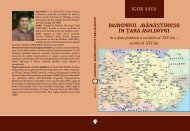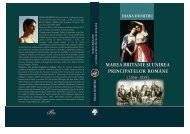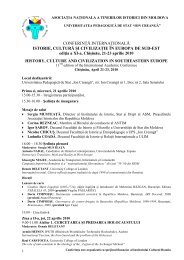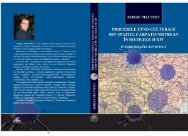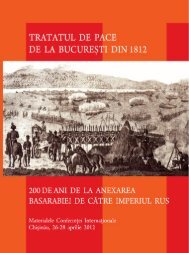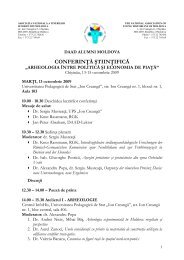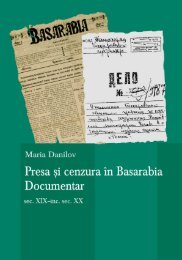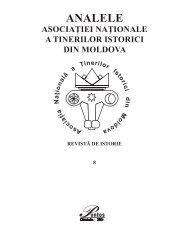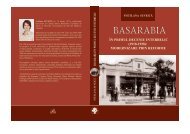LUCIA SAVA, Viaţa cotidiană în oraşul Chişinău la - Asociatia ...
LUCIA SAVA, Viaţa cotidiană în oraşul Chişinău la - Asociatia ...
LUCIA SAVA, Viaţa cotidiană în oraşul Chişinău la - Asociatia ...
You also want an ePaper? Increase the reach of your titles
YUMPU automatically turns print PDFs into web optimized ePapers that Google loves.
228<br />
Lucia Sava<br />
At the beginning, in Chisinau, the <strong>la</strong>rgest industrial center of Bessarabia,<br />
70-80% of artisans were small independent entrepreneurs. Craftsmen situation<br />
in Chisinau, registered under the 1897 Census, was as follows: in total<br />
10,150 people were present, including permanent residents of the city without<br />
a visa for residence - 8100 individuals, and temporary record for the period of<br />
validity of passports – 2 983 people.<br />
Among craftsmen were recorded over 100 specializations: male and<br />
female clothing tailors, shoemakers, carpenters, sobari, builders, b<strong>la</strong>cksmiths,<br />
butchers, bakers, furs, etc. Basarabian cities (including in Chisinau), about<br />
half of artisans sewed clothing, while only 10% sewed shoes, while in vil<strong>la</strong>ges<br />
the situation was exactly reversed.<br />
Their most assured presence on account of its commercial activities and<br />
crafts. According to historian V. Zhukov, small entrepreneurs can be divided,<br />
in terms of their re<strong>la</strong>tionship to market in three categories. The first type is<br />
most craftsmen (tailors, shoemakers, millers, leather, bakers, butchers, etc..),<br />
Whose activity was mostly re<strong>la</strong>ted to specific market on the grounds that<br />
they performed their goods here. The second category fell artisans working<br />
in the command (masons, builders, p<strong>la</strong>sterers, roofers, etc.).. Less numerous<br />
were the third category, which fell craftsmen serving a narrow band of users,<br />
enabling also to control (<strong>la</strong>the, engravers, painters, giuvaergii, painters of<br />
icons).<br />
The trade is one of priority branches of city economy. According to<br />
testimony historian Nico<strong>la</strong>e Iorga, merchants are especially Hebrew and<br />
Greek, second Bulgarian, Russian. Complete their representatives among the<br />
merchants of the petty bourgeoisie, nobles, peasants.<br />
The number, increasing the middle c<strong>la</strong>ss, ethnically diverse, is determined<br />
by strengthening industrial and commercial activities in town. It can be<br />
divided conventionally into four categories:<br />
a) The economic bourgeoisie - industrial, commercial, manufacturing, etc.<br />
(which included merchants, manufacturers, bankers, business owners);<br />
b) The intellectual bourgeoisie, represented by a fairly wide range of professions<br />
(doctors, <strong>la</strong>wyers, engineers, architects, teachers of all grades, etc.);<br />
c) The officials - persons employed in state service;<br />
d) The lower middle c<strong>la</strong>ss - called the lower stratum of the bourgeoisie, which as<br />
employed, practiced crafts and retail trade.<br />
Chisinau revenues were higher than those obtained in other cities and<br />
rural areas of Bessarabia. Raportuui variations between revenue and expenditure<br />
have been pursued in the official city leadership, but also the different<br />
social categories such as deputies or employees of the administrative system,



